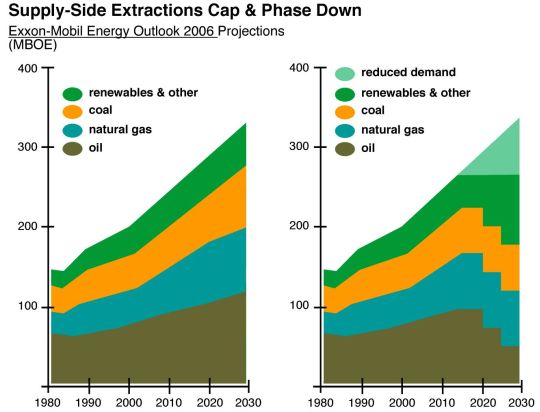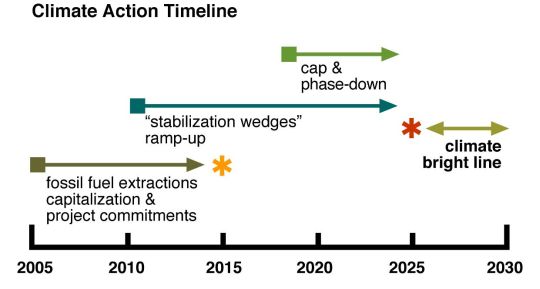The supply-side solution developed in the Bright Lines exercise, drawing on Bill Hare’s Greenpeace International paper “Climate Protection: The Carbon Logic” (PDF), won little support from first readers. It is included in this proposal as a concept to be explored because no other solution could be determined to meet the dictates of the climate timeframe — and the strong responses it provokes are evidence of its strong narrative value.
A supply-side response — imposing a cap on extractions in 2015 with 10 percent reductions at 5 year intervals until emissions are stabilized at pre-industrial levels, as shown in the accompanying chart, for example — is the ideal climate policy. A cap and phase-down would set clear market parameters for fossil fuels phase-out and establish future economies of scale for renewables and efficiencies, encouraging early investment and driving innovation. Capping extractions would, in effect, move forward the global response to exhaustion of oil and gas reserves, a great challenge even if climate change were not a problem.
 A supply-side solution would employ a minimum governmental intervention to maximum effect, defining broad parameters within which market forces would determine how best to the meet the challenge, driving rather than requiring technological innovation and social change. Lost opportunity costs would fall in direct proportion to benefits already derived by companies and nations from exploitation of fossil fuels (and almost certainly buffered by incentives and limited buy-outs of fossil fuel corporations). Remarkably, a supply-side policy is a fair, free-market solution.
A supply-side solution would employ a minimum governmental intervention to maximum effect, defining broad parameters within which market forces would determine how best to the meet the challenge, driving rather than requiring technological innovation and social change. Lost opportunity costs would fall in direct proportion to benefits already derived by companies and nations from exploitation of fossil fuels (and almost certainly buffered by incentives and limited buy-outs of fossil fuel corporations). Remarkably, a supply-side policy is a fair, free-market solution.
Two critical advantages of a cap and phase-down over any other response are:
- It is the only mechanism by which emissions reductions can be guaranteed.
- It is the only effective action that can be taken in the small window of opportunity that will be opened by significant climate change impacts and closed when the bright line is reached.
Fossil fuel extractions, transport, and refining are large industrial operations concentrated in a few known locations, many in remote regions, easily monitored. 50% of the world’s supply of oil is pumped from 120 oil fields and that number will decline as extractions are are further concentrated in the next decade. A last-minute, multi-lateral response using international policy powers to level off oil, gas, and coal supply is a far more logical and plausible course of action than the alternative, which probably entails draconian governmental rationing and sharp mandatory emissions limits, massive programs of untried carbon capture and, potentially, techno-crackpot schemes like lofting a giant Mylar umbrella into geostationary orbit between earth and sun.
Under what conditions might the drastic measures of cap and phase-down be considered?
If the world relies on the present mix of energy efficiencies, emissions reductions, alternative energy, and carbon-capture proposals assumed in current international treaty negotiations and advanced in the U.S. climate agenda, a functional international plan of action must be put in place by no later than 2015, based on energy market emissions projections and 15-year timeframe of the Stabilization Wedges analysis. There is no evidence to suggest that a functional global response will be put in place within the eight years remaining.
The small window of opportunity which may open when present efforts fail is within the twilight zone between political and climate bright lines, designated on the accompanying chart by two red stars. A fossil fuel supply cap and phase-down, imposed as a desperate measure in the twilight, would be a hardship measure, but environmentally sound and not civilization-wrecking, and so infinitely preferable to the chaos of abrupt climate change.
Bringing the world’s largest and richest corporations and most powerful, nuclear-weapon equipped nations to such drastic action strikes most people as fantastical and is easily dismissed, even by most environmentalists. The impact of a supply-side solution on energy corporations and nations with large fossil fuel reserves is indistinguishable, however, from any successful effort, other than massive carbon sequestration, which must reduce fossil fuel demand at precisely the same rate as a supply-side cap. Any other assumption is to compare apples and oranges. Supply-side is not impractical compared to other global solutions; there are no functional global solutions.
 Considerable strategic and narrative advantages are gained by endorsing a last-minute supply-side option.
Considerable strategic and narrative advantages are gained by endorsing a last-minute supply-side option.
Policy. An extractions cap complements other proposals and can provide an umbrella for a variety of functional climate policies. Ross Gelbspan proposes a three-point international response in a closing chapter of Boiling Point, for example, including:
- subsidy shift from fossil-fuel supports to clean-energy sources by developed nations;
- technology transfer of clean-energy technologies to developing countries, funded by a small levy on global commerce, and;
- incorporating a Fossil Fuel Efficiency Standard, rising by 5 percent per year, in the Kyoto treaty.
This is a simple, comprehensive global solution that would work if sufficient political will were mustered. Greenhouse Development Rights, advanced by EcoEquity, is another comprehensive proposal aimed at breaking the impasse between first world and developing nations.
A supply-side solution of last resort is compatible with both approaches (indeed it strengthens them by contrast) and can be advanced as an overall umbrella policy, enabling advocates of Greenhouse Development Rights, Gelbspan’s platform, and other comprehensive proposals to act in concert, bypassing debate on the finer points of policy and focusing attention on the key questions of politics and power.
International Strategy. A supply-side cap squarely targets the fossil fuel extractions industry and the handful of nations with large oil, coal, and gas deposits, permitting environmentalists to shift away from the myriad of national-level campaigns to join forces in a focused international campaign and clarifying who the bad guys are.
Narrative. Finally, and perhaps most importantly, a climate story that incorporates the supply-side solution is simple, clear, and compelling.
Defining Our Goal. Capital investment trends and timelines provide independent support for the <10 year climate science timeframe for global action. The International Energy Administration (IEA) recently boosted its estimate of investment requirements to meet global energy demand in the next 25 years to $20 trillion (PDF), equal to total 1990 gross global product, with just $500 billion allotted to renewables, or 3 percent of total global investment.
Interestingly enough, the cost of inaction on climate change is also pegged at $20 trillion in a Tufts University report [Climate Change: the Costs of Inaction, Report to Friends of the Earth, F. Ackerman, E. Stanton, 2006, PDF], and capital requirements for a crash global program to develop oil alternatives are also estimated to cost $20 trillion in a recent U.S. Department of Energy study (PDF) on peak oil.
The levels of capital investment now in contention are miniscule by comparison. The Bush administration argues that $3 billion/annual expenditures, primarily on carbon capture technology, is sufficient, while the recent UN panel report calls for spending in the range of $45 billion or $60 billion/year.
Development timelines for major fossil fuel energy projects run to a decade or longer. If the ratio between investment in fossil fuel and renewables is not reversed within ten years, the colossal weight of capital invested in oil, gas, and coal will preclude investment in alternatives and our last chance will be lost.
Double digit growth in the renewable sector looks good compared to past performance, but will accomplish no more than maintaining a miniscule market share. Only exponential growth — of a kind only possible by direct governmental intervention in the global market — can possibly achieve the necessary results. The climate action goal may, therefore, be stated as …
… preventing the planned investment of $20 trillion to increase fossil fuel supply, substituting in its place a crash global program — capitalized at the same level — to cut emissions, improve efficiencies, and develop renewables within a decade.

